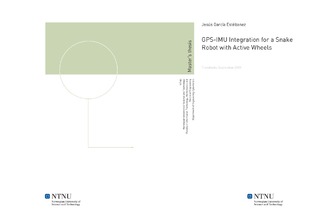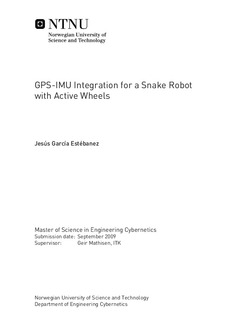| dc.description.abstract | A snake robot will be defined herein as any multilink robot for whose shape and motion capabilities are reminiscent of a snake like PiKo [1]. PiKo is a five links snake robot with active wheels designed by SINTEF in collaboration with the Norwegian University of Science and Technology (NTNU). Researchers have been greatly interested in the development of robots like PiKo because of its shape versatility and motion capacity in difficult terrains. These skills and properties are useful for rescue teams working in earthquakes, pipe inspection operations and other utilities where access and movement in the terrain are typically difficult. When a working team decides to develop a snake robot, an important point to consider is the development of an efficient navigation system that reaches an accurate position of the robot. Technically speaking, it is prudent to design at the same time a state observer that gives us at least the real time position and velocity information of the robot body to be controlled. The relevance of this information is derived from every control action applied to the robot will require some information about the situation of the robot over time. The controller will need feedback about the robot dynamics and the effect that the control actions have caused. Typically this information has three sources: the information that comes from external sensors, that from internal sensors that transmitting to the control place the measurements from the sensors in the robot body and estimated data from a physical model. All of these feedback sources have some advantages and disadvantages. Implementing an external observer, with external sensors, will not cause space problem with sensors location in the robot body, but when the robot is working inside a pipe, underground or in another hard environment where the optical, magnetic or radio frequency contact is difficult or impossible, the information reception from an external observer is too difficult and expensive or simply impossible. Locating internal sensors in the body of the robot may solve has the problem with the measurements reception, but still pose some difficulties which must be considered by the designer. Many times space becomes a problem when locating some sensors inside the robot body due to size and weight constraints within the robot body. Basing the navigation system instead on a physical model that simulates the robot motion invites the possibility of error due to simplifications taken during the mathematical and physical development. It is impossible to develop a perfect physical model since all the variables, forces, and parameters that depend on the nature characteristics usually are random process and we can just raise a useful factor estimating the average of these effects in our concrete situation. In this thesis a navigation system with a GPS (Global Positioning System) and IMU (Inertial Measurement Unit) fusion was achieved. This navigation system will be work as long the GPS signal is available. The application of the fusion technique further reduces one order the potential errors inherent in using only the GPS navigation system. When the robot will encounter locations where the GPS signal is impossible, this thesis will present a set of tools that not being a universal solution, it will be a set of mathematical tools that depending on the case could give us an accurate navigation system. During the time the GPS signal reception is impossible, this thesis presents the development and implementation of a physical model for a snake robot with active wheels which simulates the snake robot running behavior and studies the possibility to use the trajectory estimated by the model for reaching an accurate navigation system. | nb_NO |

